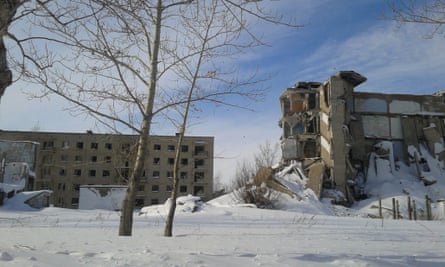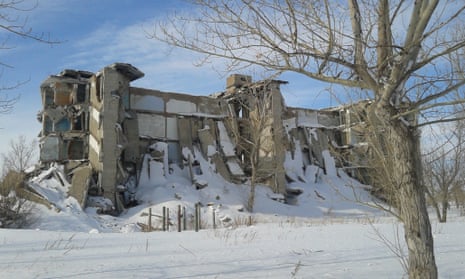One day last summer, Viktor Kazachenko set off across the steppe from his village in northern Kazakhstan. He was driving to the nearest town on some errands, but he never arrived.
“My brain switched off,” he says. “That’s it. I don’t remember.” Kazachenko had been hit by the so-called “sleeping sickness” that is plaguing Kalachi, a remote village about 300 miles west of the country’s capital Astana.
The mysterious illness has sent residents into comas, sometimes lasting days on end. “I was going to town on 28 August ,” Kazachenko told EurasiaNet.org, still disoriented by the experience. “I came round on 2 September. I understood [on waking up] in the hospital that I’d fallen asleep.”
Kazachenko blacked out while driving his motorcycle, with his wife riding with him. “It’s good it wasn’t that foreign vehicle,” he jokes, gesturing at his car standing beside his neat white cottage. “That’s fast – a motorbike isn’t so fast!”. He didn’t complain of any other injuries as a result of his sudden sleep.

The motorcycle incident was his second journey in to the land of nod – “the first time I slept for three days,” Kazachenko says, laughing. He maintains a sense of humour about his predicament but it has had serious health implications.
“After this slumber, my blood pressure started going up for no reason,” Kazachenko explained. “Headaches – that’s not the word. For six weeks, I didn’t know where to put myself. It strongly affects your mentality. I’m very on edge.”
For two years, residents have been falling into comas and suffering debilitating symptoms – dizziness, nausea, blinding headaches and memory loss – as a result.
The ailment first struck in the village in the spring of 2013 and has affected over 120 residents – around a quarter of Kalachi’s population. The latest two incidents – which hit on 1 March – have increased the total number of cases to 152. Some, like Kazachenko, have been struck more than once.
On the president’s ‘personal radar’
The ‘sleeping sickness’ is baffling doctors and scientists alike who have tested increased levels of radiation; carbon monoxide; radon and a build up of heavy metal salts which can be toxic.
Scientists say radiation is within permissible levels, as is the concentration of heavy metal salts. Elevated levels of radon and carbon monoxide were detected but later ruled out as a cause.
In January Sergey Lukashenko, the director of the National Nuclear Centre’s institute for radiation security, acknowledged that some of houses of the affected residents had carbon monoxide levels that were ten times higher than recommended. This he said, could have caused similar symptoms to the “sleeping sickness”.
Kazakhstan’s government has said the village is on the “personal radar” of president Nursultan Nazarbayev, and prime minister Karim Masimov has set up a commission to coordinate the research: by the end of last year over 20,000 laboratory and clinical test had been conducted – on the air, soil, water, food, animals, building materials, and on the residents themselves. The tests are ongoing.
Doctors are equally mystified. Sleepy patients have been sent to hospitals in the capital Astana for tests but to no avail, and the Kazakh agency Tengrinews reported that deputy prime minister Berdibek Saparbaev had turned to the international medical community for support.
Other local reports speculated that scientists from the Centre for Disease Control and Prevention in America had sent specialists in to the area. The centre did not reply to a request to confirm if this was the case.
Residents suspect uranium mine
In the absence of hard scientific facts, many residents are convinced they know the source of the problem: the disused Soviet-era uranium mine on the village’s doorstep.
“We’ve been thinking it was radiation,” says Tatyana Shumilina. “We have a uranium mine here,” although it has been “a ruin for years.”
The Krasnogorskiy mine, attached to the village of Kalachi, was once home to the miners dispatched from Russia and across the Soviet Union to extract uranium – used to power Soviet nuclear weapons and energy plants.
Krasnogorskiy is now a ghost site, gradually abandoned after the mine closed in the 1990s. Today only several dozen families remain, their homes intact but interspersed amongst desolate apartment blocks collapsing into the soil. But none of these families are thought to have been hit by the sickness, and there are no reports of the miners suffering a similar fate during Soviet times.
‘Voluntary resettlements’
“On this sleeping sickness, we don’t have the results of the studies in our hands yet,” Asel Sadvokasova, Kalachi’s mayor, acknowledged. As soon as there are conclusive findings, residents will be informed, she said.
Meanwhile, “we’re all in fear of falling asleep,” villager Tatyana Pavlenko says.
Authorities in the regions are now opting for a radical, and controversial, solution: moving the villagers out of Kalachi to prevent further exposure. In January, regional governor Sergey Kulagin said he hoped the relocation would be complete by May.
“Some measures must be taken,” the mayor, who has herself suffered a bout of the sickness, said. “This is a good chance for the residents of our village to find a new home and a new job.”
Working with local administrations and employers, authorities have already resettled around 100 residents across the Akmola Region – a 56,500-square-mile administrative area of northern Kazakhstan. But there are 425 residents still living in the village.
It is a “voluntary resettlement” Sadvokasova insists – but some villagers are resistant.

“I’m not going anywhere,” says Kazachenko. “Why should I go? I’ve been here for 40 years. I’m going to die here.”
His wife Raisa, who nursed him through two bouts of sleeping sickness is also defiant: “I’ve lived in this house for 20 years. I’ve lived on this street for 60 years,” she said , between hauling water from a standpipe through the icy streets on a sledge. “Now where will they send me? What’s awaiting me there?”
Mayor Sadvokasova acknowledges that some families don’t want to move: “For now we’re working with the families that want to resettle. It’s all on a voluntary basis.”
The authorities are “open to dialogue,” she added. In December, officials visited every home to talk to residents about their needs. They have promised that all services from schools to hospitals will be operational until the last villager agrees to leave.
Some villagers have expressed a preference for compensation but many remain opposed to leaving the place where they grew up. “They say it affects the brain; they say it gives people headaches,” Raisa Kazachenko said, “but our headache now is where we’re being resettled.”

Comments (…)
Sign in or create your Guardian account to join the discussion